新手入门葡萄酒术语及解释
葡萄酒入门之四 葡萄酒评常用术语解析

葡萄酒入门之四: 葡萄酒评常用术语解析许多品酒的介绍文章里,经常通篇都充斥着术语,其实这些术语的含义都很简单,大家不必怵头,本文争取用最简洁的语言说明一下,看完以后您就不用担心以后有人跟您掉文了,“这么简单!原来就是这么个意思。
"结构Structure旧世界的葡萄酒通常经过多种葡萄混酿而成,通过这种方式使酒的香气更加丰富。
在品尝过程中,各种葡萄的味道会按时间顺序一一析出,同时口腔中的不同位置对香味的反应也是不同的。
所谓结构,平衡,就是指各种味道之间的关系,主次分明,相辅相承。
同时,旧世界葡萄酒经常使用新、旧橡木桶混藏葡萄酒,一瓶酒中通常有30%的酒液是新橡木桶存过的,70%的酒液是旧橡木桶存放的。
品尝时,您会先后感觉到新、旧木材的香气,各种葡萄的香气,以及新旧橡木的味道互相作用,达到某种平衡关系。
层次Layer应该是不同的香味被感受的时间顺序以及相隔的时间,感觉不同香味,应当自然,不突兀,我们被之为有层次。
果香与回味Aroma & Aftertaste非陈酿的葡萄酒,较适于体现果香;较有回味的葡萄酒,一般而言需要长年的陈酿,陈年就会损失果香。
这是两种迥然不同的风格,日常餐酒都是未经陈年的,适于快速饮用,果香浓郁。
而大多数中高档葡萄,都需要陈年。
单宁Tannins葡萄酒风味的形成,几乎全部有赖于单宁物质,单宁是一种酚化合物,存在于葡萄皮、梗、籽之中。
喝葡萄酒时所感觉到的涩味,就是单宁的味道,所谓喝红酒有利于软化血管,也是指食用单宁物质有益于心血管。
由于单宁具有很强的抗氧化特性,葡萄酒要长年才能成熟,经过长期的橡木桶陈酿后,单宁逐渐被氧化,酒才特别甘醇。
橡木桶Oak陈酿的葡萄酒需要放在橡木桶中保存是因为橡木参与陈酿香气的形成。
葡萄酒在木桶内发生一系列酚化反应和氧化反应,使口味更加美妙复杂。
且橡木桶有一定的透气性,空气中的氧气会慢慢渗入使单宁更柔化,酒更圆润。
同时酒体会从木质中吸取一系列芳香物质、色素物质,使酒体更高雅,柔和。
常用的葡萄酒专业术语
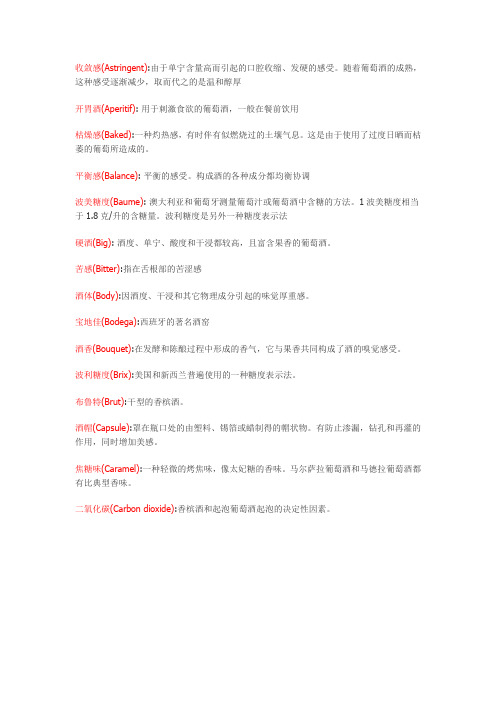
收敛感(Astringent):由于单宁含量高而引起的口腔收缩、发硬的感受。
随着葡萄酒的成熟,这种感受逐渐减少,取而代之的是温和醇厚
开胃酒(Aperitif): 用于刺激食欲的葡萄酒,一般在餐前饮用
枯燥感(Baked):一种灼热感,有时伴有似燃烧过的土壤气息。
这是由于使用了过度日晒而枯萎的葡萄所造成的。
平衡感(Balance): 平衡的感受。
构成酒的各种成分都均衡协调
波美糖度(Baume): 澳大利亚和葡萄牙测量葡萄汁或葡萄酒中含糖的方法。
1波美糖度相当于1.8克/升的含糖量。
波利糖度是另外一种糖度表示法
硬酒(Big): 酒度、单宁、酸度和干浸都较高,且富含果香的葡萄酒。
苦感(Bitter):指在舌根部的苦涩感
酒体(Body):因酒度、干浸和其它物理成分引起的味觉厚重感。
宝地佳(Bodega):西班牙的著名酒窑
酒香(Bouquet):在发酵和陈酿过程中形成的香气,它与果香共同构成了酒的嗅觉感受。
波利糖度(Brix):美国和新西兰普遍使用的一种糖度表示法。
布鲁特(Brut):干型的香槟酒。
酒帽(Capsule):罩在瓶口处的由塑料、锡箔或蜡制得的帽状物。
有防止渗漏,钻孔和再灌的作用,同时增加美感。
焦糖味(Caramel):一种轻微的烤焦味,像太妃糖的香味。
马尔萨拉葡萄酒和马德拉葡萄酒都有比典型香味。
二氧化碳(Carbon dioxide):香槟酒和起泡葡萄酒起泡的决定性因素。
必须了解的葡萄酒术语

品酒、品尝(Tasting)就是“试喝”葡萄酒,通过试喝可以了解葡萄酒的口味、香气、色泽等。
盲饮(Blind Tasting)盖住酒瓶的酒标来试喝。
通过色、香、味来猜测葡萄品种、酒标、生产年份等。
换瓶醒酒、过酒(Decantage)为了清除瓶底的葡萄酒沉淀物,而把酒瓶上部清澈的葡萄酒倒入其他容器(醒酒瓶)里的做法。
勃艮第(Bourgogne)法国东部的葡萄酒产区,由荣纳省(Yonne)、夜丘(Cote de Nuits)、波恩丘(Cote de Beaune)、莎隆内丘(Cote de Chalonnaise)、马孔内(Maconnais)、薄酒莱(Beaujolais)等6个区组成。
出产的酒,酒瓶形状是女性化的“削肩”形。
波尔多(Bordeaux)法国西南部的葡萄酒产区,梅铎(Medoc)、格拉芙(Graves)、苏玳(Sauternes)、柏美洛(Pomerol)、圣特美隆(St.Emilion)等区是有名的产地,酒瓶形状是男性化的“耸肩”形。
年份(Vintage)指的是葡萄的采收年份。
葡萄的好坏决定着葡萄酒的品质,所以“年份”成为酒是否美味的判断指标。
酒窖(cellar)冰藏瓶装葡萄酒的冰库。
男/女侍酒师(sommelier/sommeliere)一手包办从葡萄酒的进货管理到客户服务等事宜的葡萄酒专家,也需要进行资格鉴定考试。
酒厂、酒园(Domaine)勃艮第地区用来栽种葡萄、酿造葡萄酒的地方。
酒庄、酒堡(Chateau)波尔多地区用来栽种葡萄、酿造葡萄酒的地方。
贵腐葡萄酒口感圆润、香醇的甜白酒。
采用被灰霉菌(botrytis cinerea)感染的葡萄酿造而成的甜葡萄酒。
DRCDomaine de La Romanee Conti(罗曼尼-康帝酒厂)的简称。
勃艮第地区的顶级酿酒厂,生产著名的“罗曼尼-康帝”葡萄酒。
风土条件(Terroir)葡萄园周围环境和土地特性的总称。
包括土壤、地形、气候等。
葡萄酒服务术语

葡萄酒服务术语葡萄酒是一种古老而优雅的饮品,享受葡萄酒需要一定的知识和技巧。
在葡萄酒的世界中,有许多专业术语用于描述葡萄酒的特点和品质。
本文将介绍一些常见的葡萄酒服务术语,帮助读者更好地理解和品味葡萄酒。
1. 酒庄(Château):指的是葡萄酒的产地,通常是指法国波尔多地区的葡萄酒庄园。
酒庄的名称通常与葡萄酒品牌相同,代表着特定地区和生产工艺。
2. 葡萄品种(Grape Varietal):指的是葡萄酒中所使用的葡萄的品种。
不同的葡萄品种会给葡萄酒带来不同的风味和特点,如赤霞珠、黑皮诺等。
3. 年份(Vintage):指的是葡萄酒的生产年份。
年份的好坏会对葡萄酒的品质产生重要影响,一些优秀的年份会被列为特殊的收藏酒。
4. 味道(Flavor):指的是葡萄酒在口中所呈现的风味。
葡萄酒的味道可以是果味、香草味、木材味等,通过品鉴可以更好地感受和辨识葡萄酒的味道。
5. 香气(Aroma):指的是葡萄酒在杯中散发出的香气。
葡萄酒的香气可以是花香、果香、香料等,香气的复杂度也是评价葡萄酒品质的重要指标之一。
6. 酒体(Body):指的是葡萄酒的质地和口感。
酒体可以是轻盈、中等或浓厚,这取决于葡萄酒的酿造方式和葡萄的成熟度。
7. 酒液色泽(Color):指的是葡萄酒的颜色。
葡萄酒的颜色可以是白色、粉红色、浅红色、深红色等,颜色的深浅和透明度也是评价葡萄酒品质的重要指标之一。
8. 口感(Texture):指的是葡萄酒在口中的触感。
口感可以是柔顺、丝滑、干涩等,口感的平衡和持久度也是评价葡萄酒品质的重要指标之一。
9. 喝酒温度(Serving Temperature):指的是葡萄酒的最佳饮用温度。
不同类型的葡萄酒有不同的最佳饮用温度,过低或过高的温度都会影响葡萄酒的口感和风味。
10. 适合搭配的食物(Food Pairing):指的是将葡萄酒与特定食物搭配,以达到更好的味觉体验。
不同类型的葡萄酒适合搭配不同的食物,搭配得当可以相辅相成,提升食物和葡萄酒的味道。
最新葡萄酒鉴赏术语大全
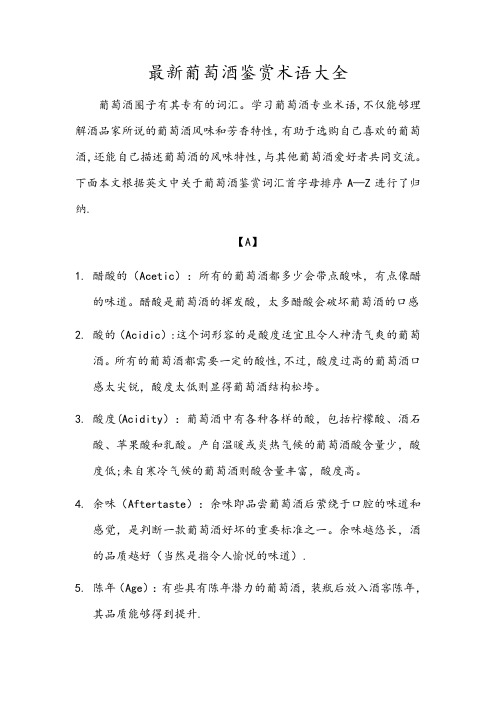
最新葡萄酒鉴赏术语大全葡萄酒圈子有其专有的词汇。
学习葡萄酒专业术语,不仅能够理解酒品家所说的葡萄酒风味和芳香特性,有助于选购自己喜欢的葡萄酒,还能自己描述葡萄酒的风味特性,与其他葡萄酒爱好者共同交流。
下面本文根据英文中关于葡萄酒鉴赏词汇首字母排序A—Z进行了归纳.【A】1.醋酸的(Acetic):所有的葡萄酒都多少会带点酸味,有点像醋的味道。
醋酸是葡萄酒的挥发酸,太多醋酸会破坏葡萄酒的口感2.酸的(Acidic):这个词形容的是酸度适宜且令人神清气爽的葡萄酒。
所有的葡萄酒都需要一定的酸性,不过,酸度过高的葡萄酒口感太尖锐,酸度太低则显得葡萄酒结构松垮。
3.酸度(Acidity):葡萄酒中有各种各样的酸,包括柠檬酸、酒石酸、苹果酸和乳酸。
产自温暖或炎热气候的葡萄酒酸含量少,酸度低;来自寒冷气候的葡萄酒则酸含量丰富,酸度高。
4.余味(Aftertaste):余味即品尝葡萄酒后萦绕于口腔的味道和感觉,是判断一款葡萄酒好坏的重要标准之一。
余味越悠长,酒的品质越好(当然是指令人愉悦的味道).5.陈年(Age):有些具有陈年潜力的葡萄酒,装瓶后放入酒窖陈年,其品质能够得到提升.6.浓烈的(aggressive):指葡萄酒酸度过高,或单宁粗糙。
7.美国法定葡萄种植区(American Viticultural Area,AVA):负责管理酿酒业的美国酒类、烟草和武器管理局(现为美国联邦酒精烟草税务贸易局,简称 TTB)在借鉴旧世界国家葡萄酒原产地概念的基础上制定了 AVA 制度。
与法国 AOC 制度并不相同,AVA 不划分等级,只是对地理位置的划分,为了将其区别于周围产区.8.尖刻的(Angular):这种葡萄酒一般也是酒体清瘦的。
这与酒体厚实,丰满圆润的葡萄酒相反。
9.芳香(Aroma):一般用于形容年轻的葡萄酒所散发的香气。
10.收敛性(Astringent):具有收敛性的葡萄酒也具有较高的单宁(单宁粗糙或尖锐,通常是由未完全成熟的酿酒葡萄所酿造出来的)。
葡萄酒品鉴的基本术语

葡萄酒品鉴的基本术语葡萄酒是一种具有悠久历史的饮品,它有着丰富的风味和复杂的口感,因此在品鉴过程中需要使用一些特定的术语来描述和评价葡萄酒的品质。
本文将介绍一些葡萄酒品鉴的基本术语,帮助读者更好地理解和欣赏葡萄酒。
1. 颜色:葡萄酒的颜色可以提供关于葡萄酒类型和年份的线索。
常见的颜色包括淡黄色、金黄色、琥珀色和红色等。
颜色鲜艳而清澈的葡萄酒通常表示年份较年轻,而较为暗淡的颜色可能意味着葡萄酒经过了较长时间的陈酿。
2. 香气:葡萄酒的香气是品尝过程中不可或缺的一部分。
葡萄酒的香气可以分为果香、花香、香料香等不同的类型。
不同的葡萄品种和酿造方法会赋予葡萄酒不同的香气特征,如黑醋栗、草莓、薄荷、香草等。
3. 口感:葡萄酒的口感是品尝过程中最直接的感受之一。
口感可以分为轻盈、丰满、柔滑、干涩等不同的属性。
轻盈的口感通常意味着葡萄酒的酸度较高,而丰满的口感则表示葡萄酒的单宁和甘甜度较高。
4. 酸度:葡萄酒的酸度是指酒液中所含的有机酸的含量。
适度的酸度可以赋予葡萄酒清新和活力的口感,而过高或过低的酸度则会使葡萄酒味道偏酸或偏平淡。
5. 甜度:葡萄酒的甜度指的是酒液中所含的残余糖分的含量。
不同的葡萄酒类型具有不同的甜度水平,从干型葡萄酒到甜型葡萄酒不一而足。
甜度可以通过观察葡萄酒的酒标上的标注来了解。
6. 单宁:单宁是葡萄酒中的一种物质,它赋予葡萄酒涩爽的口感。
单宁可以来自葡萄皮、葡萄籽和橡木桶等,它在葡萄酒的陈年过程中会逐渐变得柔和。
7. 余味:葡萄酒的余味是指品尝后在口中留存的味道。
好的葡萄酒通常具有持久的余味,余味可以带有水果、香草、坚果等不同的风味。
8. 平衡:葡萄酒的平衡是指葡萄酒中各种组分之间的和谐程度。
好的葡萄酒应该具有酒体、酸度、单宁和甜度等各个方面的平衡,没有任何一种成分过于突出。
9. 长相:葡萄酒的长相是指酒液在杯中的表现。
好的葡萄酒应该具有清澈的外观,没有悬浮物和混浊。
10. 品质:葡萄酒的品质是指葡萄酒的整体表现和口感。
红酒的十二个专业术语

酒腿指摇杯后顺着杯壁流下来的酒液。
一般而言,酒腿越多,酒体越饱满,酒精含量越高。
2—紧涩:
如果用紧涩形容一款酒,则该酒多处于年轻阶段。
口感和香气不够丰富,因此需要继续陈年才能更好的表现。
3—还原:
还原指酒精发酵期间与氧气隔绝,在这种情况下,缺氧常会在酒液里产生硫化物的味道。
4—氧化:
如果一款酒被氧化了,说明该酒充分地暴露在空气里,喝起来会有不新鲜或者陈腐的感觉。
5—醇香:
醇香主要形容成熟的葡萄酒的香气特征,成熟的葡萄酒需要很长时间才能发展出复杂的醇香。
6—单宁:
单宁天然地存在于葡萄皮,葡萄梗以及葡萄籽中,有助于葡萄酒的陈年,是一种天然的防腐剂。
7—风土:
风土是法语术语,是葡萄种植地所有自然环境的总和。
酒体指葡萄酒入口后舌头感受到的重量感,有轻、中、重之分。
9—粘度:
粘度指酒液的浓厚程度以及抵抗运动的程度。
粘度越高,究竟浓稠度越明显。
10—天鹅绒般(丝滑、顺滑):
该术语可形容一款酒的口感如天鹅绒般丝滑。
一般来说,这也意味着该酒的单宁十分柔顺。
11—单一品种葡萄酒:
单一品种葡萄酒得名于酿酒所用的特定葡萄品种。
12—干涩:
该术语用于描述口中的干涩和粗糙,多由高单宁或者高酸引起。
葡萄酒术语

酸味——存在于所有的葡萄中,是保存葡萄酒的必须组成部分。
酸味在葡萄酒中的表现特征为脆而麻辣。
回味——在吞咽下酒之后喉间酒味萦回的味道。
请参阅余味。
芳香——口感强烈花香浓郁的葡萄品种,橡木陈年以及在酒瓶中的变化而产生的香味。
麻辣——由于丹宁在葡萄酒中的作用而使喉间受到强烈刺激的感觉。
平衡——好的术语,描述了在葡萄酒中香味、酸度、干度或甜度的成分均匀而又和谐的体现。
酒体----葡萄酒在口中的感觉:或丰满或单薄,可以表达为酒体丰满,酒体均匀或酒体轻盈。
酒香——葡萄酒在装瓶陈年的过程中所形成的复杂而又多层次的味道和感觉。
干净——没有可察觉的缺点,没有难闻的味道。
复杂——好的术语,表明了葡萄酒有很多层次和味道。
酿酒师尽其所能在酿制过程中达到口味多样复杂的程度。
浓郁——强烈的香味。
瓶塞味——葡萄酒中由于变质受到污染,产生异常的口味。
清爽——非常新鲜,明显的酸味(特别是白葡萄酒)。
特酿——葡萄的混合或特殊精选。
精致——描绘了清淡或均匀的葡萄酒酿制得当,口味优雅。
新鲜——生动,干净,果实香味,是新酒的一种重要特征。
香味浓郁——具有强烈的果香味的葡萄酒。
饱满——富有一定数量酒体的葡萄酒。
生涩——未成熟的果实味道。
在薏丝琳和格乌兹来妮葡萄酒中非常和谐。
涩口——由于酸度和丹宁含量高而引起的麻辣的感觉。
余味——在吞咽下葡萄酒之后味道在嘴里萦回的时间长度。
越长越好。
轻盈或酒体轻盈——相对而言酒体比较单薄的葡萄酒。
成熟——可以饮用。
柔和——口感和谐。
有时实为甜味的委婉说法。
口感——葡萄酒及其成分在喉咙内的具体感官表现力。
无酿制年份——没有具体年份的葡萄酒,通常是由不同年份的葡萄混合而酿制出来的。
酒味——鼻子闻酒的感受。
葡萄酒的味道,也指香味。
橡木/橡木的——在葡萄酒陈年的过程中,由于酒与橡木桶接触而产生的带有橡木的香味和口感。
丰富——富有多样,丰富,愉快的香味。
圆润——平衡的酒体,不涩口的味道,没有坚硬的感觉。
沉淀一种在葡萄酒陈年的过程中所形成的葡萄酒的自然成分。
介绍酒水术语

介绍酒水术语酒水术语是用来描述各种酒类和饮品的专业术语。
以下是一些常见的酒水术语:1. 葡萄酒术语:- 干型(Dry):指没有残留糖分的葡萄酒。
- 甜型(Sweet):指残留糖分较高的葡萄酒。
- 酒精度数(Alcohol by Volume,ABV):指葡萄酒中的酒精含量。
- 年份(Vintage):指葡萄酒采摘葡萄的那一年。
- 醇厚(Full-bodied):形容口感厚重、浓郁的葡萄酒。
2. 烈酒术语:- 烈酒(Spirits):指高度酒精含量的饮品,如伏特加、白兰地等。
- 龙舌兰(Tequila):一种以蓝色剑兰为原料制成的墨西哥烈酒。
- 威士忌(Whiskey):一种将麦芽或其他谷物酿制而成的烈酒,如苏格兰威士忌、爱尔兰威士忌等。
- 伏特加(Vodka):一种无色、无味、透明的烈酒。
3. 啤酒术语:- 重口味(Full-bodied):形容口感浓郁、醇厚的啤酒。
- 苦味(Bitterness):啤酒中味蕾感知的苦味程度。
- 酒花(Hops):一种用于给啤酒增加苦味和芳香的植物。
- APEJ(Asia Pacific Excluding Japan):亚太地区(不包括日本)。
4. 咖啡术语:- 浓缩咖啡(Espresso):一种使用高压水蒸汽冲泡而成的浓郁咖啡。
- 卡布奇诺(Cappuccino):由浓缩咖啡、蒸汽牛奶和奶泡混合而成的咖啡。
- 拿铁(Latte):由浓缩咖啡和牛奶混合而成的咖啡。
以上是一些常见的酒水术语,用来描述酒类和饮品的不同特性和品尝体验。
这些术语可以帮助人们更好地理解和选择他们喜欢的酒水。
葡萄酒专业名词中英文对照
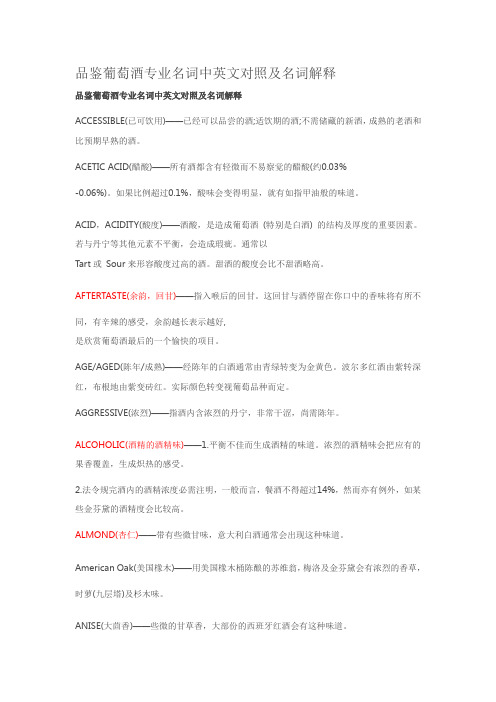
品鉴葡萄酒专业名词中英文对照及名词解释品鉴葡萄酒专业名词中英文对照及名词解释ACCESSIBLE(已可饮用)——已经可以品尝的酒;适饮期的酒;不需储藏的新酒,成熟的老酒和比预期早熟的酒。
ACETIC ACID(醋酸)——所有酒都含有轻微而不易察觉的醋酸(约0.03%-0.06%)。
如果比例超过0.1%,酸味会变得明显,就有如指甲油般的味道。
ACID,ACIDITY(酸度)——酒酸,是造成葡萄酒 (特别是白酒) 的结构及厚度的重要因素。
若与丹宁等其他元素不平衡,会造成瑕疵。
通常以Tart或 Sour来形容酸度过高的酒。
甜酒的酸度会比不甜酒略高。
AFTERTASTE(余韵,回甘)——指入喉后的回甘。
这回甘与酒停留在你口中的香味将有所不同,有辛辣的感受,余韵越长表示越好,是欣赏葡萄酒最后的一个愉快的项目。
AGE/AGED(陈年/成熟)——经陈年的白酒通常由青绿转变为金黄色。
波尔多红酒由紫转深红,布根地由紫变砖红。
实际颜色转变视葡萄品种而定。
AGGRESSIVE(浓烈)——指酒内含浓烈的丹宁,非常干涩,尚需陈年。
ALCOHOLIC(酒精的酒精味)——1.平衡不佳而生成酒精的味道。
浓烈的酒精味会把应有的果香覆盖,生成炽热的感受。
2.法令规完酒内的酒精浓度必需注明,一般而言,餐酒不得超过14%,然而亦有例外,如某些金芬黛的酒精度会比较高。
ALMOND(杏仁)——带有些微甘味,意大利白酒通常会出现这种味道。
American Oak(美国橡木)——用美国橡木桶陈酿的苏维翁,梅洛及金芬黛会有浓烈的香草,时萝(九层塔)及杉木味。
ANISE(大茴香)——些微的甘草香,大部份的西班牙红酒会有这种味道。
APPLE(苹果)——1.丰富的苹果香味,你可以在有轻微橡木味的莎当妮中品尝得到。
2.清新的苹果味是薏丝琳白酒的味道。
3.尚未成熟的葡萄酿制的白酒有青苹果味。
4.酸苹果味表示酒已开始氧化。
APRICOT(杏子)——杏味通常会在甜白酒中出现,红酒中偶尔也会出现。
葡萄酒术语表

F=法语、G=德语、I=意大利语、P=葡萄牙语、S=西班牙语、r=产区、w=白葡萄品种、b=红葡萄品种Abboccato:指葡萄酒甜度中等,酒体丰满。
(I)Acetic acid:醋酸,葡萄酒中一般都含有少量醋酸,如果含量过多,葡萄酒会更像果醋。
Adamado:甜的。
(P)Adega:酒庄。
(P)Agiorgitiko:希腊红葡萄品种,酸度低,单宁柔顺,果味浓郁突出,口感丰厚。
(b)Agliancio:意大利南部优质红葡萄品种,高酸高单宁,果香层次复杂,极富陈年能力。
(b)Albarino:分布在西班牙西北部,主要用来酿造干白葡萄酒,果香突出,酸度较高。
(w)Alcohol:酒精,即乙醇,在酒精饮料中都会出现,酒精饮料酒精含量的计算以20℃时酒精所占的体积分数为准。
Aligote:勃艮第干白葡萄酒,酸度高,价格便宜,一般不经过橡木桶陈酿。
通常这种葡萄酒都会在酒标中标出葡萄品种名称,以区别于霞多丽葡萄酒。
(w)Almacenista:指将雪利酒陈酿后批量出售的经销商。
(S)Alte Reben:老藤葡萄树。
(G)Amabile:指葡萄酒甜度中等。
(I)Anbaugebiet:法定优质葡萄酒产区。
(G)Annata:年份。
(I)Aragonez:丹魄葡萄,也称为Tinta Roriz。
(b)Assemblage:葡萄酒的调配。
指将不同类型的葡萄酒混合调配,这种做法经常出现在波尔多产区和香槟产区。
(F)Assyrtiko:白葡萄品种,果香突出,酸度较高,所酿成的葡萄酒多为干型,不经橡木桶陈酿,主要分布在希腊。
(w)Ausbruch:奥地利葡萄酒的一个等级,高级甜葡萄酒,甜度比逐粒精选葡萄酒(Beerenauslese)高,比逐粒枯萄精选葡萄酒(Trockenbeerenlese)Azienda(or casa):指同时采用外购葡萄和自身所种植的葡萄进行葡萄酒酿造的葡萄酒酒庄。
(I)Azienda(or casa)agricola:指仅采用自身种植的葡萄来酿造葡萄酒的酒庄。
葡萄酒基础专业词汇中英文对照

第一部分葡萄酒分类Dry red wine:干红葡萄酒Semi—dry wine:半干葡萄酒Dry white wine:干白葡萄酒Rose wine:桃红葡萄酒Sweet wine:甜型葡萄酒Semi-sweet wine:半甜葡萄酒Still wine:静止葡萄酒Sparkling wine:起泡葡萄酒Claret:新鲜桃红葡萄酒(波尔多产) Botrytised wine:贵腐葡萄酒Fortified wine:加强葡萄酒Flavored wine:加香葡萄酒Brut wine:天然葡萄酒Carbonated wine:加气起泡葡萄酒Appetizer wine( Aperitif):开胃葡萄酒Table wine:佐餐葡萄酒Dessert wine:餐后葡萄酒Champagne:香槟酒Vermouth:味美思Beaujolasis:宝祖利酒Mistelle:密甜尔Wine Cooler:清爽酒Cider:苹果酒Brandy:白兰地Fruit brandy:水果白兰地Pomace Brandy:果渣白兰地Grape brandy:葡萄白兰地Liquor(Liqueur):利口酒Gin:金酒(杜松子酒)Rum:朗姆酒Cocktail:鸡尾酒Vodka:伏特加Whisky:威士忌Spirit:酒精,烈酒Cognac(France):科尼亚克白兰地(法)Armagnac(France) :阿马尼亚克白兰地(法)Sherry(Spain):雪莉酒(西班牙)Port(Portuguese) :波特酒(葡萄牙) BDX:波尔多红酒第二部分酿酒微生物Yeast:酵母Wild yeast:野生酵母Yeast hulls:酵母菌皮Dry activity yeast:活性干酵母Bacteria:细菌Malolactic bacteria(MLB):乳酸菌Lactic acid bacteria(LAB):乳酸菌Acetic acid bacteria:醋酸菌Spoilage yeast:败坏酵母第三部分生理生化过程Transpiration:蒸腾作用Evaporation:蒸发Photosynthesis:光合作用Maillard Reaction :麦拉德反应Veraison:转色期Saturation:饱和Alcoholic fermentation(AF) :酒精发酵Stuck (Sluggish) Fermentation:发酵停滞Primary Fermentation:前发酵,主发酵Secondary Fermentation;二次发酵Heterofermentation:异型发酵Malolactic fermentation(MLF):苹果酸-乳酸发酵Malo—Alcohol Fermentation(MAF):苹果酸—酒精发酵Methode Charantaise:夏朗德壶式蒸馏法Maceration Carbonique :CO2浸渍发酵Whole bunch fermentation :CO2浸渍发酵Beaujolasis method:宝祖利酿造法Unareobic fermentation:厌氧发酵法Thermovinification:热浸渍酿造法Charmat method:罐式香槟法Enzymatic browning:酶促褐变Acetification:酸败Ageing:陈酿Sur lies:带酒脚陈酿Esterify:酯化Saccharify:糖化Liquefy:溶解、液化Bottle aging:瓶内陈酿Amelioration:原料改良Chaptalization:加糖Distillation:蒸馏Fractional Distillation:分馏Rectification:精馏Clarification:澄清第四部分葡萄酒酿酒辅料Betonite:膨润土(皂土)Kieselgur ,diatomite:硅藻土Capsule:胶帽Tin Plat、Foil:锡箔Pigment:颜料、色素Casein:酪蛋白Pectin:果胶酶Silica gel:硅胶Gelatin:明胶Isinglass:鱼胶Egg white:蛋清Albumen:蛋白Blood powder:血粉第五部分理化指标Total acid:总酸Titrable acid:滴定酸Residul sugar:残糖Carbon dioxide:二氧化碳Sugar—free extract:干浸出物Volatile acid:挥发酸Sulfur dioxide:二氧化硫Total sulfur dioxide:总二氧化硫Free sulfur dioxide:游离二氧化硫Copper(Cu):铜Iron(Fe):铁Potassium:钾(K)Calcium(Ca):钙Sodium(Na):钠第六部分物质名词Methanol:甲醇High Alcohol:高级醇Polyalcohol:多元醇Ethyl acetate:乙酸乙酯Flavonol:黄酮醇Glycine:甘油Calcium Pectate:果胶酸钙Ochratoxin:棕曲霉毒素Butanol:丁醇Isobutanol:正丁醇Gastric Acid:胃酸Propanone:丙酮Acetic Acid:乙酸Formic Acid:甲酸,蚁酸Phospholipids:磷脂Amino Acid:氨基酸Fatty Acid:脂肪酸Carbonic Acid:碳酸Carbohydrate:碳水化合物Fixed Acid:固定酸Tartaric Acid:酒石酸Malic Acid:苹果酸Citric Acid:柠檬酸Lactic Acid:乳酸Succinic Acid:琥珀酸Sorbic acid:山梨酸Ascorbic acid:抗坏血酸Benzyl acid:苯甲酸Gallic acid:没食子酸Ferulic Acid:阿魏酸Pcoumaric acid:香豆酸Glucose, Dextrose ,Grape Sugar:葡萄糖Fructose, Fruit Sugar:果糖Cane Sugar, Short Sweetening:蔗糖Polysaccharides:水解多糖Starch :淀粉Amylase:淀粉酶Foam:泡沫Protein:蛋白质Mercaptan:硫醇Thiamine:硫胺(VB1)Ammonium Salt:铵盐Melanoidinen:类黑精Glycerol:甘油,丙三醇Copper citrate:柠檬酸铜Copper sulphate:硫酸铜Hydrogen sulphide:硫化氢Oak (barrel) :橡木(桶)Catechins:儿茶酚Low Flavour Threshold:香味阈值Maillard Reaction:美拉德反应Volatile Phenols:挥发性酚Vanillan:香子兰Vanillin:香草醛,香兰素Linalool:里那醇,沉香醇Geroniol:.牛儿醇,香茅醇Pyranic acid:丙酮酸Furan Aldehydes:呋喃醛Eugenol:丁香酚Guaiacol:愈创木酚Carbohydrate Degradation Products:碳水化合物降解物Cellulose:纤维素Hemicellulose:半纤维素Hemicellulase:半纤维素酶Maltol:落叶松皮素Oak Lactone:橡木内酯Hydrolysable Tannins:水解单宁Ellagitannins:鞣花单宁Proanthocyanidin:原花色素Relative Astringency(RA):相对涩性Lagic Acid:鞣花酸Polypetide Nitrogen:多肽氮Oxido—reduction Potential:氧化还原电位Condenced Phenols:聚合多酚Poly—phenols:多酚PVP(P):聚乙烯(聚)吡咯烷酮Anthocyanin:花青素Alcohol, ethanol:乙醇Invert Sugar 转化糖Oxygen:氧气Ester:酯类物质Nitrogen:氮气Aroma:果香Virus:病毒Bacteriophage:噬菌体Body:酒体Byproduct:副产物Potassium Bitartrate(KHT):酒石酸氢钾Potassium Sorbate:山梨酸钾Diammonium Phosphate:磷酸氢二铵Potassium Meta—bisulfite (K2S2O5):偏重亚硫酸钾Tannin:单宁Oak tannins:橡木丹宁Undesired (Excessive )Tannins:劣质单宁Desired tannins:优质单宁Enzyme:酶Laccase:漆酶Polyphenol Oxidase(PPO):多酚氧化酶β—glucosidase:β-葡(萄)糖苷酶β—glucanase:β—葡聚糖酶Mannoproteins:甘露糖蛋白Lees:酒泥Chateau:酒庄Bulk wine、Raw wine:原酒Hygiene:卫生Activated carbon:活性碳Currant:茶蔗子属植物、无核小葡萄干Raspberry:木莓、山莓、覆盆子、悬钩子第七部分:设备Filtrate(filtration):过滤Two—way Pump:双向泵Screw Pump:螺杆泵Centrifuge:离心机Distillation:蒸馏Heat Exchanger:热交换器Crusher:破碎机Destemer:除梗机Presser:压榨机Atmosphere Presser:气囊压榨机Screw Presser:连续压榨机Filter:过滤机Bottling Line:灌装线Plate Filtration(filter):板框过滤(机)Vacuum Filtration(filter):真空过滤(机)Depth Filtration(filter):深层过滤(机) Cross Filtration(filter):错流过滤(机)Membrane Filtration(filter):膜过滤(机)Sterile Filtration(filter):除菌过滤(机) Pocket Filtration(filter):袋滤(机)Rotary Machine:转瓶机Pomace Draining:出渣Blending:调配Racking:分离(皮渣、酒脚)Decanting:倒灌(瓶)Remuage:吐渣Fining:下胶Deacidification:降酸Pump over:循环Skin Contact:浸皮(渍)Mix colors:调色Oxidative Ageing Method:氧化陈酿法Reducing Ageing Method:还原陈酿法Stabilization:稳定性Ullage:未盛满酒的罐(桶)Headspace:顶空NTU:浊度Receiving bin:接收槽Corkscrew:开瓶器Distilling Column:蒸馏塔Condenser:冷凝器Heat Exchanger:热交换器Cork:软木塞Cellar:酒窖Wine Showroom:葡萄酒陈列室Optical Density(OD):光密度Metal Crown Lid:皇冠盖Blanket:隔氧层Pasteurisation:巴斯德杀菌法第八部分:原料、病虫害、农药Grape Nursery:葡萄苗圃Graft:嫁接苗Scion:接穗Seedling:自根苗Disease:病害Botrytis:灰霉病Downy Mildew:霜霉病Powdery Mildew:白粉病Fan Leaf:扇叶病毒病Anthracnose:炭疽病Mild Powder:灰腐病Black Rotten:黑腐病Noble rot:贵腐病Pearls:皮尔斯病Phylloxera:根瘤蚜Nematode:线虫Bird Damage:鸟害Pest:昆虫Lime Sulphur:石硫合剂Nursery:营养钵Herbicide:除草剂Pesticide:杀虫剂Fungicide:真菌剂Bordeaux mixture:波尔多液Microclimate:微气候Variety:品种Cluster:果穗Rachis:穗轴Scion:接穗Rootstock:砧木Grafting:嫁接第九部分:学科名词Enology:葡萄酒酿造学Pomology:果树学Vinification:葡萄酒酿造法Wine—making:葡萄酒酿造Ampelography:葡萄品种学Viniculture:葡萄栽培学Wine Chemistry 葡萄酒化学Enologist,Winemaker:酿酒师Vintage:年份Inoculation(inoculum):接种(物)MOG(material other than grapes):杂物Terpene:萜烯Terpenol:萜烯醇第十部分葡萄酒等级法国:A。
葡萄酒专用名词及解释

葡萄酒专用名词及解释酸度( Acidity )葡萄的天然酸味。
是葡萄酒结构的主要成分及令人垂涎的因素。
单宁程度( Astringency)口腔感觉到粗糙及干涸,因为红酒内的强劲单宁程度所影响。
平衡( Balance )葡萄酒内整合的成分(包括酸、酒精、单宁等),平衡后不会有一份子稍觉突出。
膨土岩( Bentonite)中性,粉末状黏土,用以凝固葡萄酒挥发出的蛋白质,令酒味更稳定及色泽清澈。
性格( Character)用以形容酒的特质,通常与某些特别葡萄酒品种有关。
带木塞气味的( Corked)葡萄酒因木塞腐坏而使气味变劣,用以形容酒因TCA ( trichloranisole)变坏,TCA是一种发现在木塞的化学物质,变坏的酒虽然对身体无害,但气味却像发霉般。
于酒( Dry)用以形容没有甜味的葡萄酒,通常残余的糖分不会超过每公升四克的份数。
发酵(Fermentation)葡萄天然糖分发酵成酒精及二氧化碳的过程,当中有时要加入酵母以提高酒精度。
过滤( Filtering )在酒还未灌瓶前,要通过过滤方法来净化酒液,酵母细胞及其他杂质在此时会被移除。
细炼过程澄请(Fining)蛋白质(例如鸡蛋白)会被加入酒液中来移除多余的酵质,细炼过程能巩固单宁度及帮助移除悬浮物质,从而改善酒的清澈度,细炼的品质会附着杂质并沉淀至木桶底部。
最后的口感余韵(Finish)当吞咽酒液时,口腔仍残余的触觉及味道持久的口感。
自由流出(Free-run)葡萄汁或酒未压制前在酒缸内向外自动流出来的较清澈酒液。
果香味(Fruity)嫩酒的水果芳香及味道相当明显。
假若酒液觉“甜”但其实是“辣”(没有剩余的糖分)就是真正的果香味。
注种法(Inoculate)酵母被注入以使葡萄汁得以发酵。
鱼胶(Isinglass)一种特别清纯的蛋白质,从鲟鱼及其他清水鱼类的鱼胆中提炼,已在数个世纪被使用作澄清酒的物质。
渣滓(Lees)固体物一包括消耗的酵母细胞、果肉及核,在发酵及酿酒等处理时,得出的剩余品质。
奥润康:葡萄酒术语归纳
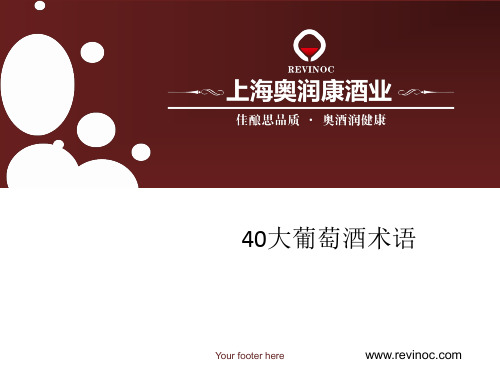
Your date here
Your footer here
3
粗俗的 Barnyard 现在的酒评家因为这样那样的理由已经很少使用这个词来形容,哪怕是一款很 糟糕的葡萄酒了。这个词意味着这款酒非常烂,糟糕透了,甚至可以说这款酒 尝起来有粪便味。 庞大 Big “庞大”意味着这款葡萄酒常常会占据整个口腔。不只有果香浓郁的葡萄酒可以 称为庞大,很多单宁强劲丰富的葡萄酒也可以被称之为庞大
华丽 Opulent 华丽这个词应该算是葡萄酒的一种基本风格了。她代表圆润,大胆和光滑的酒 体。她并不代表你就是一个浮夸的人。 精致 Refined 精致一般用来形容优雅的葡萄酒。他大多用来形容葡萄酒当中的单宁成分。
Your date here
Your footer here
10
Your date here
Your footer here
11
烘烤味 Tosty 烘烤味对于葡萄酒来说意味着这款酒必然经过橡木桶陈年。而实际上她的味道 其实并不是那么像土司。这样的葡萄酒收尾的余韵会有焦糖味。 油质感 Unctuous 油质感主要指一款葡萄酒的口感圆润顺滑。 不经橡木桶的 Unoaked 一款不经橡木桶培养的葡萄酒往往香料味缺乏,而保留有更多的果味。不经橡 木桶的白葡萄酒会有清新的柠檬味。而不经橡木桶培养的红葡萄酒网球网有更 多的浆果味。 天鹅绒般 Velvetly 这个词可以堪称是形容一款萄酒顺滑口感最高级的词汇了。如果你记得德芙巧 克力的广告,你一定不会不理解这个词。
以下为你罗列出40个常见的葡萄酒术语,准备好你的笔记本吧!
Your date here Your footer here
2
酸度 Acdity 酸度就是那些在葡萄酒当中让酒尝起来清新,有时候甚至是尖锐的成分。高酸 度让人在喝酒的时候生津。通常,一款高酸度的红葡萄酒往往颜色会比较浅, 口感也不那么圆润,而高酸度的白葡萄酒往往有柠檬或者酸橙的风味。 棱角 Angular 一款有棱有角的葡萄酒喝起来就像是在吞咽一把三角尺,酒的某一种风味在口 腔中将会非常突出。大部分情况下一款有“棱角”的葡萄酒往往是高酸度的。 不经修饰的 Austere 当我们说一款酒“不经修饰”的时候意味着这款酒非常难以入口,通常一款不 经修饰的葡萄酒往往酸度极高而果味不足。这使得这款酒尝起来缺乏实感,淡 寡无味。
葡萄酒

葡萄酒中的有机酸成份不少,都来自葡萄原汁,如酒石酸、苹果酸、柠檬酸等。有机酸能够调节神经中枢,张筋活血,对脑力和体力劳动者都是不可少的。
如果你想把酒储存一年以上,最好要放入地窖中,窖里温度最好在华氏55-60度左右,酒瓶要平放在储酒架上,或者根本不要开箱,使酒瓶按原来平放形式储存。酒在酒度变化不太大时慢慢的陈酿才好,温度太高或夏日热天太长,都会加速陈酿进程。
(九)、怎样选择葡萄酒
葡萄酒里含有啤酒和白酒中没有的果实酸,这种果实酸实际上正是葡萄酒的魅力。特别是干白葡萄酒等,因为有了这种酸味,在感到好喝以前,首先感到“酸”,因此,这就难怪您疏远葡萄酒。然而甜味可以软化酸味,它具有使其变得好喝的功能,所以最好先喝容易接受的白葡萄酒。刚开始,可以喝甜酸味搭配比较好的半甜白葡萄酒,来熟悉葡萄酒,然后再喝干白葡萄酒,玫瑰色葡萄酒等,来了解各种葡萄酒的特性。
121.20.108.* 3楼
葡萄或葡萄汁发酵成酒一般需要半个月左右,当转变成酒后则装瓶饮用,根据酒种不同,一般半年到数十年。珍品葡萄酒,要达数百年,自成酒后到饮用,这段时间成为陈酿,陈酿是酒向柔和、协调丰美转化的重要过程。一般说干白葡萄酒的陈酿时间应在一年以上,干红则最少应在一年半以上。高档干酒陈酿时间应在五年以上,浓甜葡萄酒更应如此。
5、防治心血管病的作用
葡萄酒能提高血液中高密度脂蛋白的浓度。而高浓度脂蛋白可以将血液中的胆固醇运入肝内并在那里进行胆固醇-胆酸转化,防止胆固醇沉积于血管内膜,从而防治动脉硬化。葡萄酒中的原花色素对心血管病的防治起着重要作用。在动脉管壁中,原花色素能够稳定构成各种膜的胶原纤维,能抑制住氨酸脱羧酶,避免产生过多的能降低管壁透性的组胺,防止动脉硬化。
葡萄酒专业名词中英文对照

品鉴葡萄酒专业名词中英文对照及名词解释品鉴葡萄酒专业名词中英文对照及名词解释ACCESSIBLE(已可饮用)——已经可以品尝的酒;适饮期的酒;不需储藏的新酒,成熟的老酒和比预期早熟的酒。
ACETIC ACID(醋酸)——所有酒都含有轻微而不易察觉的醋酸(约0.03%-0.06%)。
如果比例超过0.1%,酸味会变得明显,就有如指甲油般的味道。
ACID,ACIDITY(酸度)——酒酸,是造成葡萄酒(特别是白酒) 的结构及厚度的重要因素。
若与丹宁等其他元素不平衡,会造成瑕疵。
通常以Tart或Sour来形容酸度过高的酒。
甜酒的酸度会比不甜酒略高。
AFTERTASTE(余韵,回甘)——指入喉后的回甘。
这回甘与酒停留在你口中的香味将有所不同,有辛辣的感受,余韵越长表示越好,是欣赏葡萄酒最后的一个愉快的项目。
AGE/AGED(陈年/成熟)——经陈年的白酒通常由青绿转变为金黄色。
波尔多红酒由紫转深红,布根地由紫变砖红。
实际颜色转变视葡萄品种而定。
AGGRESSIVE(浓烈)——指酒内含浓烈的丹宁,非常干涩,尚需陈年。
ALCOHOLIC(酒精的酒精味)——1.平衡不佳而生成酒精的味道。
浓烈的酒精味会把应有的果香覆盖,生成炽热的感受。
2.法令规完酒内的酒精浓度必需注明,一般而言,餐酒不得超过14%,然而亦有例外,如某些金芬黛的酒精度会比较高。
ALMOND(杏仁)——带有些微甘味,意大利白酒通常会出现这种味道。
American Oak(美国橡木)——用美国橡木桶陈酿的苏维翁,梅洛及金芬黛会有浓烈的香草,时萝(九层塔)及杉木味。
ANISE(大茴香)——些微的甘草香,大部份的西班牙红酒会有这种味道。
APPLE(苹果)——1.丰富的苹果香味,你可以在有轻微橡木味的莎当妮中品尝得到。
2.清新的苹果味是薏丝琳白酒的味道。
3.尚未成熟的葡萄酿制的白酒有青苹果味。
4.酸苹果味表示酒已开始氧化。
APRICOT(杏子)——杏味通常会在甜白酒中出现,红酒中偶尔也会出现。
【精品】葡萄酒术语表
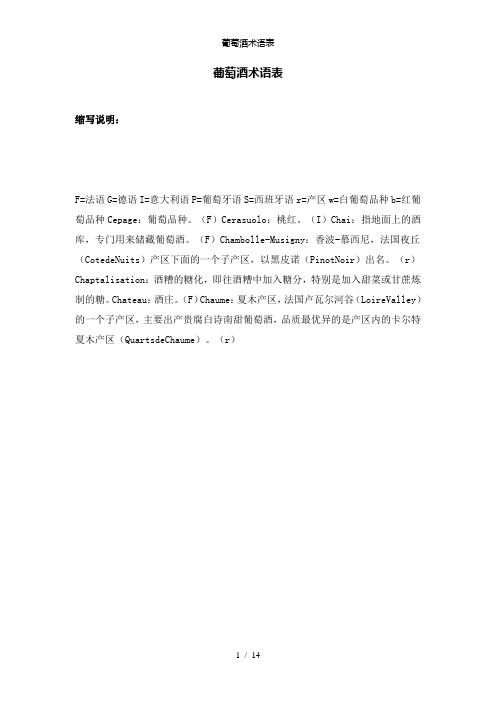
葡萄酒术语表缩写说明:F=法语G=德语I=意大利语P=葡萄牙语S=西班牙语r=产区w=白葡萄品种b=红葡萄品种Cepage:葡萄品种。
(F)Cerasuolo:桃红。
(I)Chai:指地面上的酒库,专门用来储藏葡萄酒。
(F)Chambolle-Musigny:香波-慕西尼,法国夜丘(CotedeNuits)产区下面的一个子产区,以黑皮诺(PinotNoir)出名。
(r)Chaptalisation:酒糟的糖化,即往酒糟中加入糖分,特别是加入甜菜或甘蔗炼制的糖。
Chateau:酒庄。
(F)Chaume:夏木产区,法国卢瓦尔河谷(LoireValley)的一个子产区,主要出产贵腐白诗南甜葡萄酒,品质最优异的是产区内的卡尔特夏木产区(QuartsdeChaume)。
(r)Chiaretto:颜色很浅的桃红葡萄酒。
(I)Cinsault:神索,属于红葡萄品种,适合种植在比较炎热的产区,多用来酿制桃红葡萄酒。
与歌海娜(Grenache)调配混酿,可以降低酒精含量;与佳丽酿(Carinena)调配混酿,可以减轻苦涩的味道。
Climat:指一片葡萄园。
(F)Clos:葡萄庄园,历史上指用围墙包围起来的葡萄园,现在即使葡萄园已不存在这样的围墙,但也可以称为葡萄庄园。
(F)Colombard:鸽笼白,法国南部白葡萄品种,主要用来酿造蒸馏酒和酸度较高的干白葡萄酒。
Commune:指小型葡萄酒产区,通常围绕着某个村庄。
Condrieu:孔得里约,位于法国北罗讷河谷(RhoneValley)产区,主要出产高档的干型、半干型维欧尼白葡萄酒。
Consorzio:葡萄酒贸易协会。
(I)Continentality:冬季与夏季的气温差异。
Co-operativecellar:合营酒窖。
Cornas:科尔纳斯,位于法国北罗讷河谷产区,主要出产酒体丰满的西拉红葡萄酒。
(r)Cortese:柯蒂斯,意大利北部白葡萄品种,酿成的葡萄酒多为干白,酸度较高,带有柑橘类水果风味,一般不经橡木桶陈酿。
新手入门 葡萄酒术语及解释

新手入门-葡萄酒术语及解释红酒(Red Wine)是葡萄酒的通称,并不一定特指红葡萄酒。
红酒有许多分类方式。
以成品颜色来说,可分为红葡萄酒、白葡萄酒及三类。
其中红葡萄酒又可细分为、半干红葡萄酒、半甜红葡萄酒和甜红葡萄酒,白葡萄酒则细分为葡萄酒、半干白葡萄酒、半甜白葡萄酒和甜白葡萄酒。
优雅(elegant):这是一个好的形容词,优雅一词有些人认为是不够浓郁的委婉说法,我倒认为不是。
优雅代表着一种平衡,如同交响音乐一般,各个部分在恰如其分地协奏,而没有突出某一个特定的乐器。
同时优雅也代表着香气的持久,有时细若游丝,却萦绕不散。
优雅是上好的Pinot Noir和Riesling的特点,的确有时它们的香气并不浓烈,但是复杂持久且富于变化。
酒体(Body):关于酒体因为有酒友再一次问到,所以我觉得有必要再详细地解释一下。
酒体是酒在舌头上的重量的感觉,他决定于酒精,决定于酒里面单宁和干浸出物(extraction)的多少,决定于酸度的高低。
酸度越高会显得酒体偏轻,酒精度,单宁,干浸出物高则会显得酒体偏重。
新酿造的Sauvignon Blanc通常是轻酒体的,而Barbaresco,Barolo,澳大利亚Barossa Valley的Shiraz通常是重酒体的。
了解酒体需要多多感觉,多多比较。
现在的国际趋势是越来越多的人喜欢,重的酒,也就是重酒体full- bodied。
酿造重酒体的酒本身并不困难,但是有时过重的酒体会影响葡萄酒优雅的特征,这样就叫做over-extraction。
是否能够酿造 full-bodied的酒,要根据葡萄的天生条件。
质地(Texture):上一次解释了质地的本身含义,这里要对一些形容质地的形容词作一些解释。
脆crispy,硬hard,钢铁一样的steely,这一系列词汇通常代表酸度由低到高;蜡质般的waxy,油脂般的creamy,油一样的oily,是白酒内形容较浓的葡萄酒的质感的词汇,同时也代表着酸度不高。
葡萄酒味觉常用术语及说明

葡萄酒味觉常用术语及说明滑润的所谓滑润是对一种柔和的、协调的葡萄酒而言。
由于葡萄酒经过窖藏、澄清和过滤的处理,故而显出“滑润”。
滑润的酒容易被认为是用一般的葡萄品种酿制的。
涩味的含单宁太多就涩。
这种酒特别在红葡萄酒中为数较多。
饮这种酒涩的感觉较之甜、酸来的更快。
但发涩些的酒不一定就是有缺点的酒。
经过窖藏、涩味会降低,特别是反映苦涩的色素物质降低,尤其是对红葡萄酒。
果实味的在味道上带有各种水果的味道。
诸如桃的味、杏的味、梨的味以及苹果的味等等。
纯正的纯正是好酒应有的一个重要的条件。
所谓纯正不仅是酒中主香物质和主味物质要有美妙的组合,更重要的是酒中使人感到愉快的酸应当为形成酒的整幅图景的主导因素。
酸的后味较长。
甜在纯正的葡萄酒中占主导作用,然而苦和酸配合的好的话,就会收到相得益彰的效果。
纯正的酒从来不带酒精后味,而它的酸总是对舌头起着愉快和清凉的作用。
纯正的酒应归入清凉酒的种类。
纯净的气味和味道均无瑕疵的酒才是纯净的。
它既可以是天然葡萄酒,又可以是改善酒。
无论天然酒还是改善酒,都可以按照“国家标准”“国际标准”达到纯净的水平。
那就是说,只要酒中不含任何丑恶的东西或者是什么过分的东西,酒味可口的话那么就可以称它达到纯净的标准了。
天鹅绒状的丰满柔和的名酒不仅色泽美丽,而且多汁。
甚至使你觉不出什么酒精味,人们形容它为天鹅绒状的酒。
这种酒一入口轻拂舌头,它给人以如同用手抚摩在天鹅绒上面一样。
窖藏的葡萄酒是最易产生这种情调的。
干净的被称为干净的酒是指人们对它指不出什么缺点的酒。
也就是说它是已达到正常标准的酒。
倘若有一种酒人们觉出其含有土气味,或者觉出它有木桶味或软木塞的味,这种酒基本就可称为干净的酒,“干净”是人们对于上市葡萄酒的起码要求。
酵母成分会把酒搞得不干净,不过这不是指新酒而言。
因为新酒要经过几道澄清,所以新原酒含有酵母味是自然的。
但是如果酒放置一年以后仍有酵母味,那就算不上是干净的酒了,说明酒后阶段处理的不正确或不及时、彻底。
- 1、下载文档前请自行甄别文档内容的完整性,平台不提供额外的编辑、内容补充、找答案等附加服务。
- 2、"仅部分预览"的文档,不可在线预览部分如存在完整性等问题,可反馈申请退款(可完整预览的文档不适用该条件!)。
- 3、如文档侵犯您的权益,请联系客服反馈,我们会尽快为您处理(人工客服工作时间:9:00-18:30)。
新手入门-葡萄酒术语及解释红酒(Red Wine)是葡萄酒的通称,并不一定特指红葡萄酒。
红酒有许多分类方式。
以成品颜色来说,可分为红葡萄酒、白葡萄酒及三类。
其中红葡萄酒又可细分为、半干红葡萄酒、半甜红葡萄酒和甜红葡萄酒,白葡萄酒则细分为葡萄酒、半干白葡萄酒、半甜白葡萄酒和甜白葡萄酒。
优雅(elegant):这是一个好的形容词,优雅一词有些人认为是不够浓郁的委婉说法,我倒认为不是。
优雅代表着一种平衡,如同交响音乐一般,各个部分在恰如其分地协奏,而没有突出某一个特定的乐器。
同时优雅也代表着香气的持久,有时细若游丝,却萦绕不散。
优雅是上好的Pinot Noir和Riesling的特点,的确有时它们的香气并不浓烈,但是复杂持久且富于变化。
酒体(Body):关于酒体因为有酒友再一次问到,所以我觉得有必要再详细地解释一下。
酒体是酒在舌头上的重量的感觉,他决定于酒精,决定于酒里面单宁和干浸出物(extraction)的多少,决定于酸度的高低。
酸度越高会显得酒体偏轻,酒精度,单宁,干浸出物高则会显得酒体偏重。
新酿造的Sauvignon Blanc通常是轻酒体的,而Barbaresco,Barolo,澳大利亚Barossa Valley的Shiraz通常是重酒体的。
了解酒体需要多多感觉,多多比较。
现在的国际趋势是越来越多的人喜欢,重的酒,也就是重酒体full- bodied。
酿造重酒体的酒本身并不困难,但是有时过重的酒体会影响葡萄酒优雅的特征,这样就叫做over-extraction。
是否能够酿造 full-bodied的酒,要根据葡萄的天生条件。
质地(Texture):上一次解释了质地的本身含义,这里要对一些形容质地的形容词作一些解释。
脆crispy,硬hard,钢铁一样的steely,这一系列词汇通常代表酸度由低到高;蜡质般的waxy,油脂般的creamy,油一样的oily,是白酒内形容较浓的葡萄酒的质感的词汇,同时也代表着酸度不高。
柔和smooth,圆润round,富饶rich,代表着甜味由弱到强(在干型葡萄酒里,往往意味着酒精度和橡木带来的甜味),柔和 smooth,柔软supple,丝绸般的silky,丝绒般的velvety,可咀嚼的chewy代表着得安宁从弱到强,形容单宁还可以用细致 fine,确实firmed,但是这些并非是形容质感的词汇。
Acetic. Term applied to wines which have undergone acetification and to the odour of such wines.醋酸的:用于描述发生醋酸化的葡萄酒,以及此类葡萄酒所散发出的气味。
Acid. Term applied to a wine containing an excessive amount of acid, usually a wine made from grapes not completely ripe.酸:用于描述含有过量酸的葡萄酒,通常是因为原料葡萄没有完全成熟。
After taste. Tastes left in the mouth by wines after they have been tasted.后味:品尝后葡萄酒留在口中的味道和感觉。
Agreeable. Pleasant character of a well-balanced wine.惬意的:一款平衡良好的葡萄酒所包含的宜人特征。
Amber. Colour of a wine resembling that of amber.琥珀色:葡萄酒所具有的类似琥珀的颜色。
Astringent. The characteristic flavour of wines which produces an unpleasant chemical stimulus in the mouth, due to an excessive level of ethyl acetate.涩的、收敛性的:葡萄酒中乙酸乙酯含量过高时的典型特征,给口腔带来一种不适的化学刺激感。
Aroma. The odour of wines. Primary aroma is derived from the grapes. Secondary aroma derives from fermentation. Tertiary aroma (bouquet) develops during maturation and aging.香气、果香:葡萄酒的气味。
主要的香气来自葡萄果实,次级香气来自发酵过程,而第三层香气(酒香)在葡萄酒的成熟与陈酿过程中发育。
Aromatic. Term applied to wine with a very pronounced aroma, usually made from grapes with aromatic flavour and aroma such as the Muscats.果香的:用于描述蕴含着极显着果香的葡萄酒,这些葡萄通常是以果香浓郁的葡萄如各种玫瑰香型的葡萄酿制。
Blind tasting. Tasting wines of which the origin and identity are not previously disclosed to the tasters.盲品:不事先告诉品尝者葡萄酒来源及身份的品尝。
Bitter. Taste that causes an unpleasant and persistent sensation of acridity in the mouth due, in particular, to certain polyphenols.苦的:一种引起口腔持久苦感的不适味道,特别由多酚等物质引起。
Body. The character imparted to a wine which is rich in dry extract, vinous and complete.酒体:提取物丰富、酒性饱满、完满的葡萄酒所具有的特征。
Bouquet. Odoriferous quality of a wine, particularly the odour of fine wines acquired during aging.陈香、酒香:葡萄酒的香气质量,尤其指高档葡萄酒在陈酿过程中所获得的香气。
Brilliant. Term applied to wines, particularly white wines, which are free of any visible suspended matter and have a sparkling clarity.闪亮的:用于描述葡萄酒尤其是白葡萄酒中没有任何肉眼可见的悬浮物质,表现闪闪发亮的澄清特征。
Butyric. Rancid odour of some spoiled wines.坏奶油味的:描述一些破败葡萄酒所散发出的腐臭气味。
Casky taste, woody taste. Taste imparted to wines during storage in new or badly kept casks, by substances extracted from the wood of the containers.橡木桶味、木头味:当葡萄酒在新橡木桶或保存不好的橡木桶中存放时,由容器木料中溶解出的物质赋予葡萄酒的味道。
Cleared. Term applied to a wine which was deposited its suspended material and become clear.澄清过的:用于描述沉淀出其中的悬浮物质后变得澄清的葡萄酒。
Cooked taste. Taste acquired by must or wine when heated to high temperatures, particularly if heated in the presence of air. Aroma or taste coming from grape crops which are over ripe.烹烤味:当葡萄汁或葡萄酒在高温下加热,尤其是在与空气接触的条件下加热时所产生的一种口感。
也指来自过熟的葡萄的香气和口感。
Corked taste, corkiness, corky. Taste imparted to bottled wines by defective or mouldy corks.酒塞味:装瓶后的葡萄酒由于酒塞低劣或发霉变质而带上的味道。
Decanter. A special glass bottle, usually glass-stoppered, used for serving wine that has been removed from its original container, in order to facilitate the perception of its aroma.醒酒瓶:特殊的玻璃瓶,通常配有玻璃塞,用于供应从原来的包装瓶中倒出的葡萄酒,以促进对葡萄酒香气的欣赏。
Delicate. Term applied to the flavour and aroma of some fine wines. A delicate wine is light, well-balanced and soft.精雅的:用于描述一些优质葡萄酒的风味和果香。
精雅的葡萄酒轻盈、平衡良好而柔和。
Dull. Term applied to wines which have a distinct colloidal haze, but which are free of visible suspended material. Hazy. Wine with faint turbidity.暗淡的、沉滞的:葡萄酒中含有明显的胶状薄雾,但不存在肉眼可见的悬浮物质。
朦胧的:葡萄酒表现轻微的浑浊。
Earthy taste. Special taste resulting from the type of soil on which the grapes were grown.泥土味:由栽培葡萄的土壤类型所赋予葡萄酒的特殊口味。
Fine. Term applied to wines of high quality.细腻的:用于描述具有高品质的葡萄酒。
Flavour. Impression given wine taken into the mouth. Includes sensations gained by the taste organs and also by the olfactory receptors.风味:品尝对葡萄汁或葡萄酒的总体印象。
